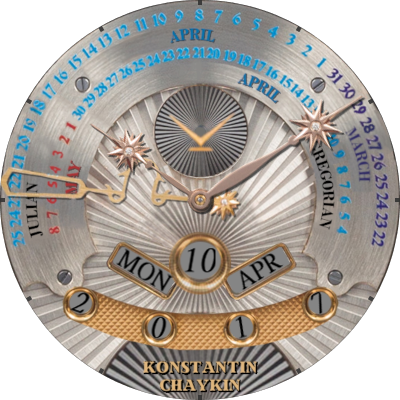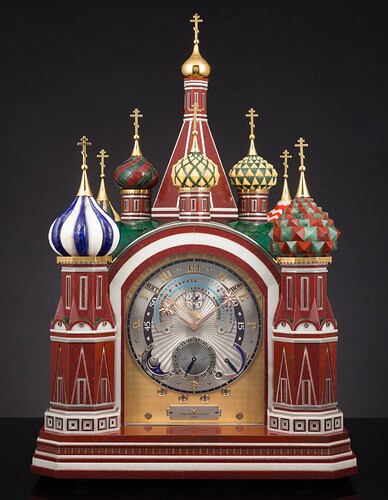This clockskin is my adaptation of one of the four faces of the Konstantin Chaykin Moscow Computus Clock. The supercomplicated astronomical table clock “Moscow Computus Clock”, created by Konstantin Chaykin, is the most complex clock ever created in Russia.
In addition to the time, day, date, month and year, the clockskin displays the 2024 Orthodox Easter date on both the Gregorian calendar commonly used today (May 5th) and the ancient Julian calendar on which the Orthodox Easter date is based (April 22nd). [The Julian calendar is currently 13 days behind our Gregorian calendar used today.]

[Note: The Orthodox Easter date hand on the clockskin is frozen at the 2024 date.]
Credit: Konstantin Chaykin Moscow Computus Clock
Clockskin Download Zip File: Konstantin Chaykin Moscow Computus Clockskin
Here is an image of one of the four sides of the original clock:
Here is the video of my .watch version watch face of this clock, which includes all four sides accurately functioning, including the side with a tellurium*, the side displaying sidereal time** and the side with an analemma***. In my opinion, the analemma is fascinating in its accurate display of the “Equation of Time”**** over the course of the year. Numerous other complications are also included.
*A tellurium is a model that represents the motions of the Moon around the Earth and the Earth around the Sun.
** Sidereal time, used for astronomy (star-gazing), is the time as measured by the apparent motion about the Earth of the distant, so-called fixed, stars, as distinguished from solar time, which corresponds to the apparent motion of the Sun. The primary unit of sidereal time is the sidereal day, which is almost 4 minutes shorter than the mean solar day of 24 hours shown by ordinary timepieces.
*** An analemma is a diagram showing the position of the Sun in the sky as seen from a fixed location on Earth at the same mean solar time each day, as that position varies over the course of a year.
**** The Equation of Time is the difference between apparent solar time (which directly tracks the motion of the sun) and mean solar time (which tracks a theoretical mean sun with uniform motion).

